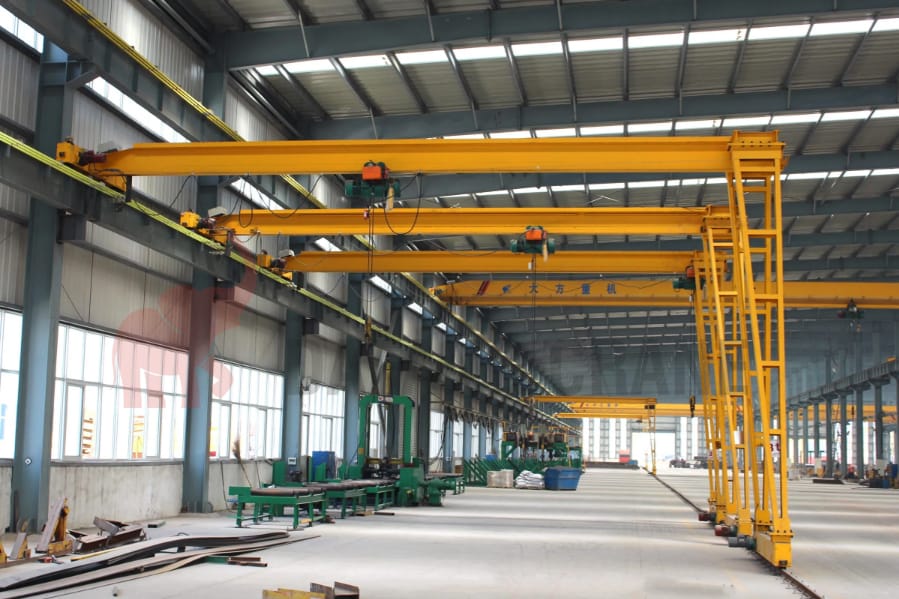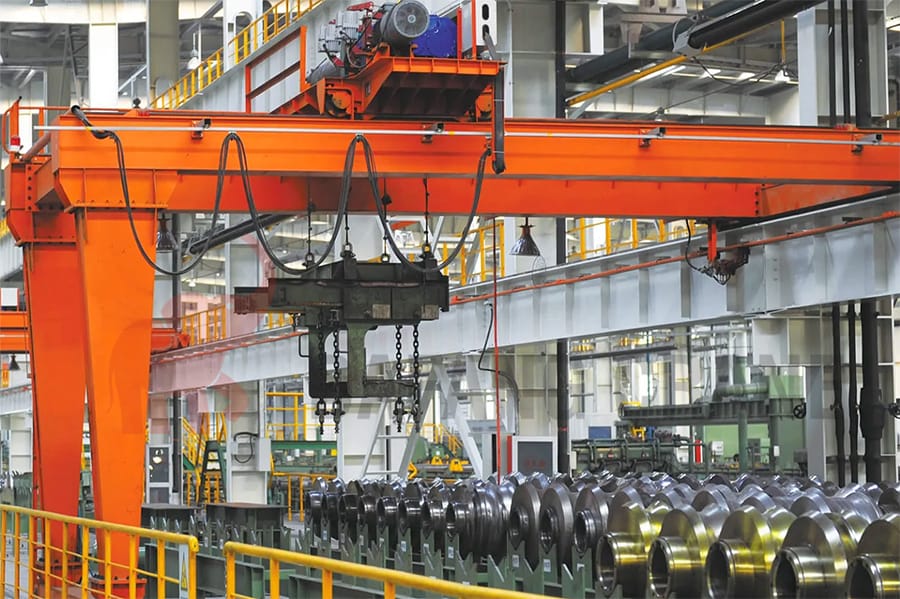Semi Gantry Cranes: Types And Application
What are Semi-Gantry Cranes?
Semi gantry cranes are a type of gantry crane that has one end supported by a runway, while the other end travels on wheels along a track on the ground. The supporting end can be fixed or moveable depending on the design of the crane. These cranes are versatile and have a wide range of applications due to their ability to handle loads of varying weights and sizes.
Types of Semi Gantry Cranes
There are two main types of semi gantry cranes:
Single Girder Semi Gantry Crane
Single girder semi-gantry cranes are designed to handle medium to heavy lifting capacities, typically ranging from 3-20 tons. They have one main girder spanning the gap between the ground-level rail and the gantry beam. The trolley hoist moves along the length of the girder and lifts the load with a hook attached to the hoist. The single girder design makes these cranes lightweight, easy to operate, and cost-effective. They are ideal for lighter loads and smaller workspaces.

Double Girder Semi Gantry Crane
Double girder semi-gantry cranes are designed to handle heavier loads and offer greater lifting heights than single girder options. They have two main girders spanning the gap between the ground-level rail and the gantry beam. The trolley hoist moves along the length of the girders and lifts the load with a hook attached to the hoist. Double girder half gantry cranes are ideal for handling larger loads and can be customized with additional features like lights, warning devices, and anti-collision systems.

Applications of Semi Gantry Cranes
Semi-gantry cranes have a wide range of applications in different industries. Some of the most common applications include:
Manufacturing Industry
Semi gantry cranes can be used in the manufacturing industry. They offer a flexible and reasonably priced alternative for lifting and transporting big items of machinery and equipment on the factory floor. They are also great for moving parts, finished products, and raw materials throughout production.
Warehousing Industry
Single leg gantry cranes are a popular choice for warehouses that require efficient loading and unloading of goods. They can operate within confined spaces and are capable of handling heavy loads. They are perfect for moving pallets, crates, and containers from trucks to storage areas.
Machine Shops
In a machine shop, semi-gantry cranes are used to move heavy materials and machinery, load and unload raw materials. Semi-gantry cranes can easily lift and move heavy loads within the confined space of the shop floor, so they are ideal for use in machine shops. They are also versatile, suitable for a variety of tasks from material handling to maintenance and assembly line production.
Construction sites
Semi-gantry cranes are frequently employed there to lift and move large building materials including pipes, concrete blocks, and steel beams. Additionally, they are employed for the lifting and positioning of prefabricated parts like walls and flooring.
Power plants
In power plants, heavy machinery like turbines, generators, and boilers is maintained and repaired using semi-gantry cranes. The heavy pieces and equipment are also moved about the plant using them.
Advantages of Using Semi-Gantry Cranes
Increased Work Area
Semi Gantry Cranes can cover a larger work area compared to other types of cranes. Semi gantry cranes are designed with a single leg that runs along a rail on the ground while the other side of the crane is supported by a structure such as a building or a column. Due to their design, single leg gantry cranes can cover a greater work area than traditional overhead cranes that are limited by the length of the runway system.

Improved Efficiency
Using a semi-gantry crane can increase the effectiveness of material handling procedures. With a larger work area, workers can move more materials at once, reducing the need for multiple lifts and transfers. Semi-gantry cranes can also be fitted with sophisticated automation and control systems, increasing productivity and efficiency even more.
Cost-Effective
Semi-gantry cranes are a cost-effective option. Semi-gantry cranes may be constructed more quickly and with less support structure than conventional overhead cranes, which lowers installation and maintenance costs. They may also be quickly moved if necessary, giving organizations that must adjust to shifting work conditions a more adaptable option.
Safety System Configuration Of The Crane
The safety system of a semi-portal crane includes several components that work together to keep workers and equipment safe during operation. These components include limit switches, overload protection systems, emergency stop buttons, and warning devices such as lights and alarms.
Proper configuration of these components is critical to ensuring that the crane can operate safely and efficiently. For example, limit switches are used to prevent the crane from over traveling or colliding with other objects. Overload protection systems are designed to prevent the crane from lifting loads that exceed its capacity, which could cause the crane to tip over or drop the load.
Emergency stop buttons are another important component of the safety system. These buttons allow workers to quickly shut down the crane in the event of an emergency, such as a worker getting caught in the crane’s hoisting mechanism.
Maintenance of Semi Gantry Crane
One key component of a semi-portal crane that requires regular attention is the hoisting mechanism. This includes inspecting the hoist rope for signs of wear, checking the drum for proper alignment, and verifying that the hoisting brake is functioning correctly.
Other components that require regular inspection and maintenance include the trolley wheels, end carriages, and electrical systems. Trolley wheels should be inspected for wear and adjusted or replaced as needed. End carriages should be checked for alignment and any loose or damaged bolts. Electrical systems should be inspected for frayed wires, blown fuses, and malfunctioning relays.
The frequency of maintenance tasks will depend on a variety of factors, such as the crane’s age, usage, and operating environment. However, as a general rule, it’s a good idea to perform routine maintenance on a semi-portal crane at least once every six months.
It’s also important to keep the semi-portal crane clean, especially in dusty or corrosive environments. Regular cleaning can help prevent dirt and debris from building up on critical components and causing premature wear or failure.
FAQs
- What is the difference between a semi gantry crane and a full gantry crane?
A semi gantry crane has one end of the bridge supported by a gantry system, while the other end is supported by a leg that runs on a runway. A full gantry crane has both ends supported by a gantry system. - What are the different types of half-gantry cranes?
There are two main types of semi gantry cranes: single girder and double girder. - What applications are semi-gantry cranes used for?
Semi-gantry cranes are commonly used in manufacturing, warehousing, port operations, and construction. - What are the benefits of using a single-leg gantry crane?
Semi gantry cranes require less space than a full gantry crane, are more cost-effective, can be customized to fit specific requirements, and are versatile. - Which type of half gantry crane is best for heavy lifting?
Double girder semi gantry cranes are typically used for heavy lifting applications.
Send Your Inquiry
- Email: sales@hndfcrane.com
- WhatsApp: +86-191 3738 6654
- Tel: +86-373-581 8299
- Fax: +86-373-215 7000
- Add: Changnao Industrial District, Xinxiang City, Henan Province, China





































































